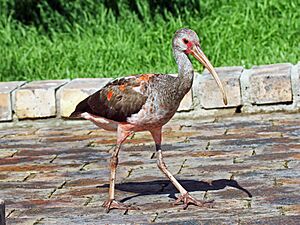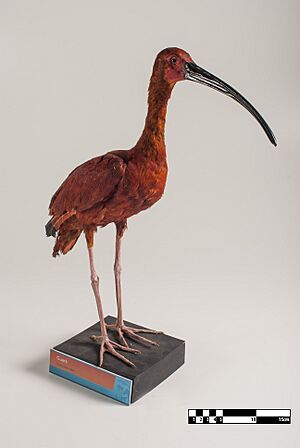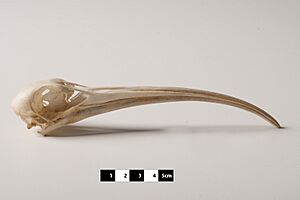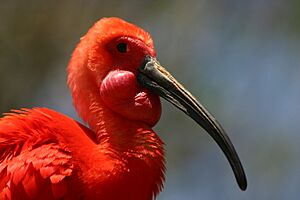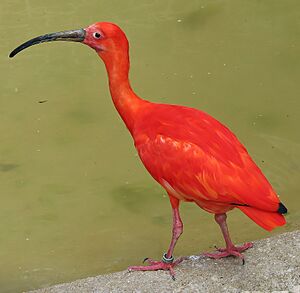Scarlet ibis facts for kids
Quick facts for kids Scarlet ibis |
|
|---|---|
 |
|
| A scarlet ibis at L'Oceanogràfic | |
| Conservation status | |
| Scientific classification | |
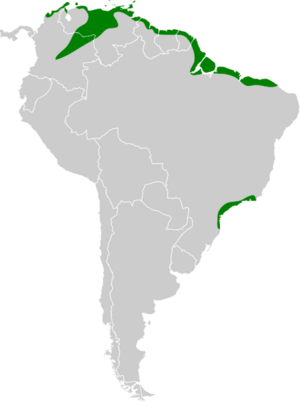 |
|
| Synonyms | |
|
The scarlet ibis, also known as the red ibis, is a beautiful bird with bright red feathers. Its scientific name is Eudocimus ruber. This amazing bird lives in warm, tropical parts of South America and some Caribbean islands.
The scarlet ibis looks like other ibis birds, but its super bright red color makes it easy to spot! It's so special that it's one of the two national birds of Trinidad and Tobago. In some parts of Brazil, its local name, guará, is even part of city names.
This medium-sized bird loves to wade in water. It's strong and there are many of them, so it's not in danger of disappearing. It is protected around the world. Scientists are still discussing if the scarlet ibis is its own unique species or a type of another American ibis, like its cousin, the American white ibis.
Contents
About Scarlet Ibis Classification
The scarlet ibis was first named by a famous scientist named Carl Linnaeus in 1758. He first called it Scolopax rubra, which means "red woodcock" in Latin. Later, its name changed to Eudocimus ruber.
The scarlet ibis is very closely related to the American white ibis. They look almost exactly alike in their bones, claws, beaks, and feathers. The main difference is their color! For a long time, scientists thought they were two completely different species.
But recently, researchers have seen the red and white ibises mating in the wild. They found hybrid birds that were pale orange or white with some orange feathers. This makes some scientists think they might be the same species, with just different colors. However, because the two colors stay separate in the wild, other scientists still think they are different species.
What Does a Scarlet Ibis Look Like?
Adult scarlet ibises are almost completely bright red. Their feathers can have different shades of red. The only part that isn't red are the tips of their longest wing feathers, which are a dark black or sometimes dark blue. Their red color is so bright, it almost glows!
Scarlet ibises have red beaks and feet, though their beaks can sometimes be blackish at the end. Their beaks are long, thin, and curved downwards. When they fly, their legs and neck stretch out long.
Young scarlet ibises are grey, brown, and white. As they grow, they eat a lot of red crustaceans, which helps them get their scarlet color. The color change starts when they are about to fly, and it takes about two years for them to become fully red. The scarlet ibis is the only shorebird in the world that is red.
Adult birds are about 55 to 63 centimeters (21 to 25 inches) long. Males are a bit bigger than females, weighing about 1.4 kilograms (3 pounds). Their beaks are also longer. These birds can live for about 16 years in the wild and 20 years in zoos. An adult scarlet ibis has a wingspan of about 54 centimeters (21 inches).
Even though they spend a lot of time walking or wading, scarlet ibises are very strong flyers. They often fly long distances in large groups, forming a "V" shape in the sky.
Where Do Scarlet Ibises Live?
Scarlet ibises live in many places across South America and the Caribbean. You can find them in Brazil, Colombia, French Guiana, Guyana, Suriname, and Venezuela. They also live on islands like the Netherlands Antilles and Trinidad and Tobago.
These birds like to gather in wet, marshy places. This includes muddy areas, shorelines, and even rainforests. Some groups have been seen further south in Brazil, near cities like Joinville.
The largest groups of scarlet ibises are found in the Llanos region of western Venezuela and eastern Colombia. This area is a big, flat, tropical grassland. It's a safe place for them away from people. Here, the scarlet ibis and its relative, the bare-faced ibis, are very common.
Sometimes, scarlet ibises fly to other places by accident. They have been seen in Belize, Ecuador, Panama, and even the United States. However, most scarlet ibises seen in North America today are birds that escaped from captivity.
Scarlet Ibis Behavior
Breeding and Life Cycle
Scarlet ibis pairs build simple nests, usually loose platforms made of sticks. They like to build their nests in the leaves of young mangrove trees near water. They prefer wet, muddy areas like swamps, but they build their nests high up in trees for safety. If possible, they nest on islands, where their eggs and chicks are safer from predators.
To attract a female, the male performs special dances. These include preening his feathers, shaking, making bill-popping sounds, rubbing his head, and flying high. After mating, the female lays three to five smooth eggs. These eggs usually hatch in about 19 to 23 days. Once the eggs hatch, both parents work together to care for their young.
In southeastern Brazil, ibises gather in large groups in mid-September. They start building nests in early November. All the female birds in a group tend to lay their eggs around the same time.
What Do Scarlet Ibises Eat?
Scarlet ibises use their long, thin beaks to search for food in soft mud or under plants. Many people think they only eat shrimp, but a recent study showed they eat a lot of insects. Most of these insects are scarab beetles and ground beetles.
They also eat many shrimp and other small sea creatures. This includes ragworms, snails, small crabs, and crayfish. The large amount of shrimp and other red shellfish they eat gives them a special red chemical called astaxanthin. This chemical is what makes their feathers so brightly colored!
Sometimes, scarlet ibises also eat frogs, small snakes, small fish, fruits, and seeds. When these birds live in zoos, their food often includes beetroot and carrots. This helps them keep their bright red color.
In the Llanos region, seven different types of ibis live together. Scarlet ibises are the most aggressive there. They sometimes try to steal food from other bird species. They have also been seen following other birds or even farm animals to catch insects that get stirred up.
Social Behavior
The scarlet ibis is a very friendly bird. They like to live in groups and work together to find food and protect their young. They usually live in flocks of 30 or more birds. Members of the group stay close to each other. Mating pairs build their nests close to other pairs in the same tree.
For extra protection, large groups of several thousand ibises often gather together. They also fly and feed with other birds like storks, spoonbills, egrets, herons, and ducks. Being in a big mixed group helps keep them safer.
Scarlet Ibis Status
The scarlet ibis is a protected species around the world. The International Union for Conservation of Nature says it is a species of "Least Concern". This means it is not currently in danger of disappearing.
Even though some local groups of scarlet ibises are getting smaller, the total number of birds worldwide is still large. So, the current losses are not seen as a threat to the species' survival. However, some recent declines in French Guiana have worried conservationists. In Brazil, the bird is now on a national list of endangered species.
Scarlet Ibis and People
The scarlet ibis and another bird called the rufous-vented chachalaca (or cocrico) are the national birds of Trinidad and Tobago. Both birds are shown on the country's coat of arms of Trinidad and Tobago. The cocrico is found on Tobago, while the scarlet ibis is linked to Trinidad.
An important place for the scarlet ibis is the Caroni Swamp wildlife sanctuary in Trinidad. This is a large wetland area that was set aside in 1953 especially to protect the scarlet ibis.
The scarlet ibis has also inspired writers. American author James Hurst wrote a famous short story called "The Scarlet Ibis" in 1960. Another short story by Margaret Atwood called "Scarlet Ibis" is in her book Bluebeard's Egg. The name also belongs to a book of poems by American poet Susan Hahn.
Images for kids



